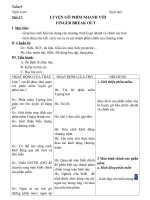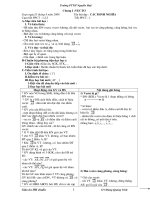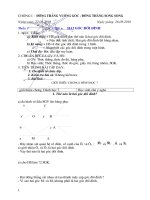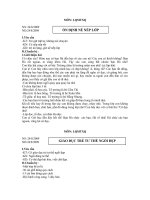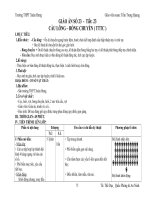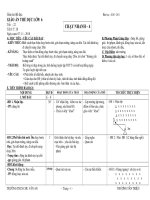Giao an PTNL mau 2019
Bạn đang xem bản rút gọn của tài liệu. Xem và tải ngay bản đầy đủ của tài liệu tại đây (366.32 KB, 17 trang )
WEEK:20
Period: 55
Preparing date:
Teaching date:
Unit 7: RECIPES AND EATING HABITS
Lesson 1 - GETTING STARTED: My favourite salad
I./. OBJECTIVE: By the end of the lesson, students can:
- use the lexical items related to making a prawn salad
- listen and read Nick's mum and Mi's conversation for specific information about
how to make a spawn salad
- Learn some more famous dishes of some countries in the world
1. Knowledge: - Vocabulary: lexical items related to making a prawn salad
- Grammar: Giving instruction
2. Skills: Practicing skills
3. Attitude: - Positive about recipes and eating habits
- Students know how to learn English in right way.
- Ss are interested in doing exercises.
4. Competences:
- Co-operation
- Self- study
- Using some vocabularies and structures to talk about their favourite dishes and
recipes for dishes
II./.PREPARATION:
1.Teacher: book, planning, picture, laptop, projector
2.Students: books, notebooks
III./. TEACHING METHODS: Communicative approach, group Ss and T’s
activities, play as a character, teaching methods with game, teaching methods by
visual, teaching methods by practising, discussion group, technical present….
IV./.PROCEDURE:
Teacher and Students' activities
Content
1.Warm up: Brainstorming
Find out famous dishes of some countries in the
* Find out famous dishes of some world
countries in the world
Countries
Dishes
- Teacher elicits and write the name Viet Nam
of some countries on the board
Thailand
? Discuss and find out some famous Japan
or tradition dishes of these
The USA
countries
Mexico
- Have some students write the
The UK
dishes on the right corner of the
Italy
board
India
2.Getting-started:
I. New words
New words
- prawn
(n):
tôm panda
Teacher use the things in the - celery
(n):
cần tây
Teacher and Students' activities
picture on page 6-7 to teach new
words
- Follow the seven steps of teaching
vocabulary
Listen and read
? Cover the text and look at the
picture on page 6-7
? Who can you see in the picture?
? Where are they?
? What is there on the table?
- mayonnaise
- versatile
Content
(n):
sốt ma-i-on-ne
(adj) đa dụng
II. Listen and read
* Suggested answers:
- Mi, Nick and his mom.
- In the kitchen.
- prawn, celery, lemon. salt, pepper, mayonnaise,
knife, tablespoon.......
? What do you think they are - They are talking about how to make a salad.
talking about?
- Play the recording and have
students follow along.
? Compare your answer with the
information in the dialogue.
1.a. Find the words (1a P8)
1.a. Find the words (1a P8)
? Work individually to find the 1. starter
2. versatile
words with the given meanings in 3. drain
4. peel
the dialogue.
5. chop
6. combine
? Quickly write the answer on the
board.
1.b. Word webs (1b P8)
1.b. Word webs (1b P8)
? Work in pairs and complete the * Ingredients: prawn, celery, lemon. salt, pepper,
word webs.
mayonnaise, spring onion
- Call one pair to write their * Preparing and cooking: wash, boil, combine,
answers on the board.
chop, peel, drain, mix, add
? Add more if needed.
1.c. Answer the questions (1c P8)
1.c. Answer the questions (1c P8)
? Run through the questions.
1. Nick's mum.
- Make sure students understand 2. Because it's simple and delicious.
them.
3. In the summer time.
? First, answer the questions 4. They are versatile, and you can use lots of
without reading the dialogue again. ingredients in a salad.
? Exchange your answer with your 5. Nick's mum boils and drains the prawns, and
partner.
mixes the ingredients. Mi washes the spring onions,
? Read the dialogue again and chop the celery, peels the onions, and mix the
check.
ingredients.
6. Because he finds it difficult to wait for one hour.
3.Doing:
III. Practice
1. Matching (2 P8)
1. Matching (2 P8)
? Refer back to the warmer
A. Cobb salad
B. sushi
? Look at the pictures and match C. steak pie
D. fajitas
the dishes with the pictures.
E. lasagne
F. mango sticky
Teacher and Students' activities
? Pair compare
- Play the audio for students to
check and repeat the answers.
2. Discussion (3a P8)
? Work in pairs to discuss what
country in the box is associated
with each dish in 2.
- Check and confirm the correct
answers.
3. Fill in each blank with the
name of a dish. (3b P8)
? Complete the sentences with the
name of the dishes in 2.
? Write the answer on the board
4. Food quiz (4 P8)
? Work in groups to do the quiz
Content
rice
G. beef noodle soup
H. curry
2. Discussion (3a P8)
A. The USA
C. The UK
E. Italy
G. Viet Nam
B. Japan
D. The UK
F. Thailand
H. India
3. Fill in each blank with the name of a dish. (3b
P8)
1. lasagne
2. curry
3. steak pie
4. Fajitas
5. sushi
4. Food quiz (4 P8)
Suggested answers
1. beef
2. prawn, potato
3. cheese, butter, ice cream
4. strawberry, lychee, cherry, promegranate
5. broccoli, spinach, lettuce, celery, kohlrabi
4.Further practice:
? Recall some dishes
5.Production;
? Learn by heart new words
? Do exercises B1-3 P4-5 Learn by heart new words
(workbook)
Do exercises B1-3 P4-5 (workbook)
Prepare: Unit 7: A closer look 1
Prepare: Unit 7: A closer look 1
---------------------0@0-------------------WEEK:20
Period: 56
I./. OBJECTIVE: :
Preparing date:
Teaching date:
Unit 7: RECIPES AND EATING HABITS
Lesson 2: A closer look 1
By the end of the lesson, students can:
- learn some more words related cooking verbs
- remember the instructions on how to make a pizza
- Identify the tone in statements used as questions and say these sentences correctly.
1.Knowledge: - Vocabulary: words related to cooking verbs and making a pizza
- Grammar: Imperative
2. Skills: Practicing skills
3. Attitude: - Positive about recipes and eating habits
- Students know how to learn English in right way.
- Ss are interested in doing exercises.
4. Competences:
- Co-operation
- Self- study
- Using some vocabularies and structures to talk about their favourite dishes and
recipes for dishes
II./.PREPARATION:
1.Teacher: book, planning, picture, laptop, projector
2.Students: books, notebooks
III./. TEACHING METHODS: Communicative approach, group Ss and T’s
activities, play as a character, teaching methods with game, teaching methods by
visual, teaching methods by practising, discussion group, technical present….
IV./.PROCEDURE:
Teacher and Students' activities
Content
1.Warmer: Word webs
Word webs
- Elicits the topic from students
* Suggested answer:
? Work in two teams
Dishes: Cobb salad, sushi, steak pie,
? Brainstorm all the words related to fajitas, lasagne, mango sticky rice, beef
the topic: dishes and preparing/ noodle soup,
curry
cooking
Preparing and cooking:wash, boil,
- Encourage them to call out as many combine, chop, peel, drain, mix, add
words as possible.
2.Vocabulary:
I. New words
- Teacher use the pictures in 1 on page - whisk
(v): đánh (trứng)
9 to teach vocabulary (situation, - grate
(v): nạo
realia)
- spinkle
(v): rắc
- Follow the seven steps of teaching
- manirate (v) ướp
vocabulary
(v): phết
- spread
(v): om
- simmer
(n): mì ống, mì sợi
- paster
(n): bột (nhão) làm bánh
- batter
II. Vocabulary
1. Matching (1 P9)
1. Matching (1 P9)
? Match the verbs in the box with the A. chop
B. slice
pictures.
C. grate
D. marinate
E. whisk
F. dip
G. sprinkle
H. spread
2. Complete the sentences (2 P9)
2. Complete the sentences (2 P9)
? Work in pairs.
1. chop, Slice
2. grates,
? Use the correct form of the verbs in sprinkles
1 to complete the sentences.
3. Marinate
4. whisk
5. Dip
6. spread
3. Matching (3 P9)
3. Matching (3 P9)
? Run through all the cooking verbs.
1.g
2. f
Teacher and Students' activities
? Read the definition and match a
cooking verb in A with its definition
in B.
? Work individually
4.a. Questions (4a P9)
? Look at the picture and answer the
two questions.
? Pair compare
- Elicit their answers
? Have you ever eaten or made a
pizza?
? If so, do you like the dish?
? Describe the process of making one
briefly.
4b. Complete the instruction (4b
P10)
? Look at the pictures and complete
the instructions individually.
? Then compare the answer with a
partner.
- Check the answer as a class.
? Can you make a pizza after reading
the instructions.
3. Pronunciation
* Tone in statement used as
questions
? What is a statement?
- a telling sentence that ends with a
full stop.
? What is a statement question?
- used to check information has the
order of a statement but ends with a
question mark.
- Play the part of the conversation in
GETTING STARTED which includes
a statement question.
? Listen and pay attention to the
intonation of the sentences, give
comment.
? Read the REMEMBER box.
- Make sure students understand the
information
1. Listen and draw
or
(5
Content
3. h
5. e
7. d
4. c
6. a
8. b
4.a. Questions (4a P9)
- tomato sauce, onion, cheese, apple,
bacon, pizza base -> pizza
4b. Complete the instruction (4b P10)
1. Chop
2. Grate
3. Spread
4. Sprinkle
5. Spread
6. Bake
III. Pronunciation
* Tone in statement used as questions
- A statement can be used as a question to
check that the information we have is
correct.
- When we pronounce a statement
question, our voice goes up at the end.
1. Listen and draw
or
(5 P10)
Teacher and Students' activities
Content
P10)
? Listen to the conversations and draw
correct symbol for the intonation of
each sentence.
- Play the recording as many times as
necessary.
? Practice the conversations with a
partner.
2. Complete the mini-dialogues (6 2. Complete the mini-dialogues (6 P10)
P10)
* Suggested answers:
? Work in pairs to complete the minidialogues with suitable statement
questions.
1. You don't like paster?/ Don't like
- Call on some pairs to write their paster?
answers on the board.
- Give comment when needed.
2. Add some salt?
? Practice the dialogues using the
correct intonation.
4.Further practice:
? Recall some cooking verbs.
? How is a statement question
pronounced?
5.Production:
? Learn by heart new words
Learn by heart new words
? Do exercises A1,2 P3 (workbook)
Do exercises A1,2 P3 (workbook)
? Prepare: Unit 7: A closer look 2
Prepare: Unit 7: A closer look 2
---------------------0@0-------------------WEEK:20
Preparing date:
Period: 57
Teaching date:
Unit 7: RECIPES AND EATING HABITS
Lesson 3: A closer look 2
I./. OBJECTIVE: - Grammar: Quatifiers, Modal verbs in conditional sentences type 1
- Vocabulary: words related to dishes
1.Knowledge: conditional sentences type 1 with modal verbs
2. Skills: Practicing skills
3. Attitude: - Ss are interested in using Quatifiers, Modal verbs in conditional sentences
type 1
- Positive about recipes and eating habits
- Students know how to learn English in right way.
- Ss are interested in doing exercises.
4. Competences:
- Co-operation
- Self- study
- Using some vocabularies and structures to talk about their favourite dishes and
recipes for dishes
II./.PREPARATION:
1.Teacher: book, planning, picture, laptop, projector
2.Students: books, notebooks
III./. TEACHING METHODS: Communicative approach, group Ss and T’s
activities, play as a character, teaching methods with game, teaching methods by
visual, teaching methods by practising, discussion group, technical present….
IV./.PROCEDURE:
Teacher’s and students’ activities
1.Warmer: Check the old lesson
Content
2.Grammar 1: Quantifiers:
Ask students what a quantifier is, briefly
explain to them that quantifier is a word or
phrase that expresses the amount. Tell
students that they had already learnt and
know quite a few quantifiers. Elicit
examples from students.
T may organize a short warm-up activity
with this content. Students work in pairs
to write down all quantifiers that they
know in two minutes. The winner in the
pair with has the most answers.
Activity 1:
1 Ask Ss about the use of the four
quantifiers. Make any necessary
comments. Have Ss do this exercise
individually and then compare their
answers in pairs.
Tell Ss that when talking about recipes
people usually use food quantifiers and
that the Look out! box contains the most
common ones.
Have Ss read the information in the Look
out! box. Explain any unclear points. If
time allows, ask Ss to give examples with
the quantifiers. Ss may also add some
more food quantifiers they know to the
list.
1 Fill each blank with o, an, some,
or any.
Key:
1.a
2. a
3.
some
4. some/any
5. a
6.
some
7. an
8. any
9. Some
2 Match the food quantifiers with
the nouns. Some quantifiers can
go with more than one noun.
Key:
1.a, g 2. a
5.h 6. b,d
3.f,g 4.c
7.e,f 8. b
3 Read the instructions to make
a salad. Fill each blank with a
word/phrase in the box.
Key:
1.200grams
2. an
3. tablespoons 4. teaspoon
5. teaspoon
6. some
Activity 2 :
2 Have Ss do the exercise individually
and then compare their answers with a
partner. Remind them that some
quantifiers can go with more than one
noun. Check the answers as a class.
3.Grammar 2:
Activity 3 : 3 a Have Ss work in pairs to
read the instructions to make a chicken
salad and to fill each blank with a word/
phrase from the box. Check as a class.
b Ask Ss to work in pairs, and think about
a simple salad they know. Together Ss
write the instructions to J make it Call on
some pairs to read aloud their
instructions. Other Ss listen, make
comments, and vote for the best salad.
T may also organise a competition. Have Ss
work in groups to write the instructions to
make a salad on a big piece of paper. Once
they have finished, each group sticks their
instructions on the board. A board of five
Ss act as examiners. This board reads the
instructions and gives each group a mark.
Activity 4 :
b Work in pairs. Think about a
simple salad Write the
instructions on how to make it
using the quantifiers and cooking
verbs you have learnt. Share the
instructions with the whole class.
Vote for the best salad.
4. Modal verbs in conditional
sentences type 1
4 Read these sentences from the
conversation in GETTING
STARTED. Pay attention to the
underlined part and answer the
questions.
In conditional sentences type 1, we
use a simple present tense in the Ifclause and will + bare infinitive in
the main clause. This is the
standard form.
Instead of will, we can use other
modal verbs such as can, must, may;
might or should in the main clause
to express ability, permission,
advice, possibilities, necessity, etc.
Example:
If you cut your finger, it will bleed.
(standard form)
If you finish your dinner, you can
watch TV. (permission)
She can learn to become a good
cook if she tries hard, (ability) if he
likes eating spicy food, he
may/might add chilly, (possibility)
If you don't want to get burnt, you
must follow these safety
instructions. (necessity)
If you feel unwell, you shouldn't eat
fast food. (advice)
Key: I
Ask them to give the standard form of 1. ability 2. Advice
If + S + V (present simple),
conditional sentences type 1.T may call on
one student to write the form on the s + can/must/may/might/should
+ V (infinitive).
board. Now have Ss read the information
and examples in the grammar box. Write
5 Match the first half of the
the form of the examples on the board:
sentence in A with the second
half in B.
Have Ss read the two given sentences and
answer the questions. Elicit their answers
and confirm the correct ones.
4.Further practice:
Activity 5
5 Have Ss do the exercise individually and
then compare their answers in pairs. Ask
some Ss to read out loud the complete
sentences.
Key:
1. c 2. e
d
Activity 6
6 Have Ss work in pairs to read the
situations and write appropriate
//-sentences. Call on some Ss to write
their sentences on the board. Give
necessary correction.
If time allows, organise a quick game. Ss
work ỉn groups and write down two
situations. After five minutes, have a
representative from one group stand up
and read out one situation. This student
points at a random student in another
group to give a conditional sentence type 1
with a modal verb. If the sentence is
correct, the group gets one point. The
groups take turns to read their situations.
The winner is the group with the most
points. Make sure the groups have equal
opportunities to give the answers.
Example:
3. a 4. b 5. f 6.
6 What will you say in these
situations? Use suitable modal
verbs with conditional sentences
type 1.
Your friend, Mai, is not good at
cooking, but she wants to study
abroad. You think learning to cook
is a good idea because she can cook
for herself when she's away from
home. Give her some advice.
—> If you want to study abroad, you
should learn to cook.
Suggested answers:
1. If you want to have good health,
you must reduce the amount of salt
in your food.
2. If my brother is hungry, he can
eat three bowls of rice.
3. You can take a cooking class if it
is at the weekend.
4. If I eat this undercooked pork, I
may have a stomachache.
5. You should whisk the eggs for
10 minutes if you want a lighter
cake.
5.Production:
Copy the email onto exercise notebook.
-Prepare communication
---------------------0@0-------------------Kiểm tra ngày
tháng
năm 2018
…………………………………………………….
……………………………………………………
……………………………………………………..
WEEK:21
Period: 58
Preparing date:
Teaching date:
Unit 7: RECIPES AND EATING HABITS
Lesson 4: Communication
I./. OBJECTIVE:
By the end of this Unit, students can:
• talk about the eating habits of Vietnamese people
• listen for detailed and specific information about teenagers' eating habits
1.Knowledge:
- Vocabulary: words related to recipes and eating habits.
- Grammar: quantifiers (review); modal verbs in conditional type 1.
2. Skills: Practicing skills
3. Attitude: - Positive about recipes and eating habits
- Students know how to learn English in right way.
- Ss are interested in doing exercises.
4. Competences:
- Co-operation
- Self- study
- Using some vocabularies and structures to talk about their favourite dishes and
recipes for dishes
II./.PREPARATION:
1.Teacher: book, planning, picture, laptop, projector
2.Students: books, notebooks
III./. TEACHING METHODS: Communicative approach, group Ss and T’s
activities, play as a character, teaching methods with game, teaching methods by
visual, teaching methods by practising, discussion group, technical present….
IV./.PROCEDURE:
Teacher’s and students’ activities
1.Warmer:
Tell students in this lesson they will have
the opportunity to learn how to cook one
Content
Look at the pictures. Answer
type of soup.
Go through that extra vocabulary with
the questions.
students. If students do not know any
words in the Box. Quickly teach it.
puree:
To teach the word shallot and cube teacher
garnish
may draw the pictures on the board . To
shallot
teach other words use simple words, use
cube
simple explanations and examples to give
tender
definitions.
pumpkin
puree: make fruit or vegetables into a thick
leaves
smooth sauce, usually in a blender
fibre
garnish decorate of food with a small
pinch
amount of another fruit.
stick
tender so easy to chew my grandmother
can only eat beef if it is tender so my
mother has to stew it from one hour
Activity 1: - Have Ss look at the picture
and answer the questions. Quickly elicit
their answers and write them on
the board. Do not confirm the correct
answers now.
2.Communication 1:
Activity 2:
bột nhuyễn
Trình bày
củ hẹ
hình lập
phương
mềm
bí ngơ
lá
chất xơ
Nhúm tay
Bó, cây
- 1 Have Ss look at the picture and answer
the questions. Quickly elicit their answers
and write them on the board. Do
not confirm the correct answers now.
2a Now listen to the first part of
2a Play the first part of the recording for Ss a talk where Mi is presenting
to check their answers. Confirm the how to prepare the ingredients.
correct ones.
Check your answers.
Key: 1. pumpkin, celery, shallots,
butter, salt, cream
b Play the recording again for Ss to do the
exercise. Have them compare their
answers in pairs. Call on two Ss to write
their answers on the board. Ask other Ss to
correct these answers if needed. Play the
recording one more time for Ss to check
their answers.
2b Listen to the first part of the
talk again. Fill each blank with
a word/phrase.
Key:
1. a kilo/one kilo 2. two
3. two sticks
4. two
tablespoons
Audio script (part 1 n Pumpkin soup is my 5. two tablespoons 6. a pinch
7. peel
8. chop
9. peel
family's favourite soup. We usually have it 11 . leaves
for breakfast with some slices of bread. It's
quick and simple to cook.
10. slice
The ingredients are: a kilo of pumpkin,
two shallots, two sticks of celery, two
tablespoons of butter, two tablespoons of
fresh cream, and a pinch of salt.
Before cooking, peel the pumpkin and
chop it into cubes. Peel the shallots and
slice them. Next, wash the celery and
remove the leaves.
3a Read the steps to make the
dish. Rearrange them into the
correct order.
3.Communication 2:Activity 3:
3a+b. Key:
3 a+b Have Ss read the steps to cook the
soup and try to rearrange the steps. Ask
some Ss to write their order on the board.
Play the recording for Ss to check their
answers. Ask Ss to comment on the orders
on the board. If there are any unclear
points, play the recording a second time.
1.b 2. e 3. f 4. c 5. a 6. d
c. Key: - a good source of fibre,
minerals, and vitamins, especially
vitamin A.
- improve your eyesight and
protect yourself from certain
C Without playing the recording again, ask cancers
Ss about the benefits of the soup. If Ss are
not sure about any points play the
recording again. Have one student talk
about the benefits.
Audio script (part 2): Here are the steps
to make the soup:
Heat the butter in a deep pan, add the
shallots and celery and stir fry for a few
minutes.
- Add the pumpkin and stir fry for a few
more minutes.
- Add 750ml of water and a pinch of salt
and cook until the pumpkin is tender. Cool
for 10 minutes.
- Purée the soup in a mixer until it is
smooth.
- Add the cream and simmer for 2 to 3
minutes.
- For the finishing touch, garnish it with
some celery leaves.
4a Work in groups. Choose a
dish you like. Discuss its
ingredients, how to prepare it
and the steps to cook it. Write
Pumpkin soup is very healthy. It's a good
source of fibre, minerals, and vitamins,
especially vitamin A. If you eat this soup
regularly, you can improve your eyesight
and protect yourself from certain cancers.
4.Further practice:Activity 4:
a Have Ss work in groups to discuss a
dish they like. Ss take notes of the
ingredients, how to prepare the dish, and
the steps to cook it on a big piece of paper.
Move around to provide any necessary
help.
your ideas on a large sheet of
paper.
Name of the dish: ...............................
Ingredients:
.................................
.........
Preparation:
.....................
..........
Steps:
..............................
Benefits of the
dish: ...............................
b. Organise a gallery walk. Move
around to each group and listen
to their presentation. Vote for
the best dish.
b Ask groups to stick their answers on the
walls around the class. Ask other Ss to
move around to each group and listen to
the group's presentation about the dish.
Have Ss vote for the best dish and explain
the reasons.
5.Production:
- Write five sentences about your good friends.
-Prepare SKILLS 1
---------------------0@0-------------------WEEK:21
Preparing date:
Period: 59
Teaching date:
Unit 7: RECIPES AND EATING HABITS
Lesson 5: Skills 1
I./. OBJECTIVE: By the end of this Unit, students can:
• read for general and specific information about the eating habits of
Japanese people
• talk about the eating habits of Vietnamese people
1.Knowledge: Vocab: favourite dishes and recipes for dishes
2. Skills: Practicing skills
3. Attitude: - Positive about recipes and eating habits
- Students know how to learn English in right way.
- Ss are interested in doing exercises.
4. Competences:
- Co-operation
- Self- study
- Using some vocabularies and structures to talk about their favourite dishes and
recipes for dishes
II./.PREPARATION:
1.Teacher: book, planning, picture, laptop, projector
2.Students: books, notebooks
III./. TEACHING METHODS: Communicative approach, group Ss and T’s
activities, play as a character, teaching methods with game, teaching methods by
visual, teaching methods by practising, discussion group, technical present….
IV./.PROCEDURE:
Teacher’s and students’ activities
1.Warmer: Chatting
2.Reading:
Activity 1:
Have Ss work in pairs to discuss the
questions. Elicit their answers. Because it
is an open activity, accept different
answers.
Activity 2:
Ask Ss to read the headings quickly. Make
sure they understand the meaning of each
heading. Now Ss read the paragraphs and
match them with the headings. Ask them
to compare their answers with a
classmate. Elicit their answers.
Content
I- READING
Work in pairs. Answer the
questions.
1. Where do the Thai people
live?
2. What is their population?
Suggested answers:
Picture A: different types of sushi
Picture B: miso soup
Picture C: a bowl of rice
Picture
D:
sliced
cucumber/pickled
cucumber
2 Now read an article about
Japanese eating habits. Match
the headings (1-3) with the
paragraphs (A-C).
raw food
flavour
sashimi
spicy
Japanese
horseradish
thực phẩm thô
biến
hương vị.
sashimi
vị cay
cải ngựa Nhật
vinegared rice
pickled ginger.
arrangement
significant
feature
staple
Bản
gạo dấm
gừng ngâm.
sắp xếp
tính năng quan
trọng
kẹp giấy
Activity 3:
3 Have Ss read the passage again to answer the
questions.
Key:
A. 3 B.2 C.1
Ss can underline parts of the text that help them with the
answers. Ask Ss to compare their answers before
givingthe questions.
3 Answer
the answers ton Ask them to give evidence when
Key: giving
the answers.
1. They like raw food and do not
use sauces with a strong flavour.
2. They cut fresh fish.
3. Both can be served with soy
sauce.
4. There are four (rice, soup,
main dish, pickles).
5. Rice is the staple food and is
very nutritious.
6.
Because the dishes are
presented in different bowls and
plates, and are arranged carefully
according to a traditional pattern.
SPEAKING
3.Speaking
1. What is the most important
This part helps Ss understand more about feature of Vietnamese eating
the eating habits of Vietnamese people.
habits?
4 Have Ss work in groups to discuss the 2. What are the typical
eating habits of Vietnamese people. Ss use components in a Vietnamese
the questions provided as cues. Move meal?
around the class to provide help. Ask the 3. What is the staple of our
groups to organise their ideas to prepare country?
4. How are the dishes arranged?
for a short presentation.
5 Have one group of students act as 5. Are there any other
examiners
and
other
groups
as characteristics of our eating habits
competitors. The groups take turns to that you know?
present their ideas. If there is not much
time left, allow about two or three groups
to present. Invite comments from the
examiners. Give additional comments.
6. In general, do Vietnamese
6.Further practice:
people have healthy eating habits?
Reference for teachers (this note
1. Vietnamese food is varied and
provides some general information; T
distinctive. It is considerably low
can add more specific details^! to
fat and high in carbohydrates.
match the context of each area)
Vietnamese eating habits
2. Traditional Vietnamese cooking
usually uses fresh ingredients,
little dairy and oil, and various
herbs
and
vegetables.
Different sauces such as fish sauce,
shrimp paste, and soya sauce are
quite popular in various regions.
There is no concept of ‘courses’ in
a Vietnamese meal.
3. A meal consists of various
Sashimi là một món ăn truyền thống lâu dishes: main dish (meat, fish, egg
đời của người Nhật với thành phần
or tofu), vegetable, soup and rice.
chính là các loại hải sản tươi sống.
Rice is the staple in Viet Nam. In
many families, people eat around a
tray of food with a small bowl of
fish sauce in the middle.
4. Around this bowl are the
dishes. If people place the food on a
table, a similar arrangement is
followed. Dishes are served
communally. Usually there is a big
dish/bowl of each dish, and people
use chopsticks and spoons to get
their share.
5. No.
6. In general, Vietnamese food is
considered healthy and is popular
in other countries.
5.Production:
- Write four sentences about your school.(answer these questions above
-Prepare SKILLS 2
Thày cô liên hệ 0989.832560 ( có zalo ) để có trọn bộ nhé.
Trung tâm GD Sao Khuê nhận cung cấp giáo án, bài soạn powerpoit, viết
SKKN, chuyên đề, tham luận, bài thi e-Learing các cấp…
